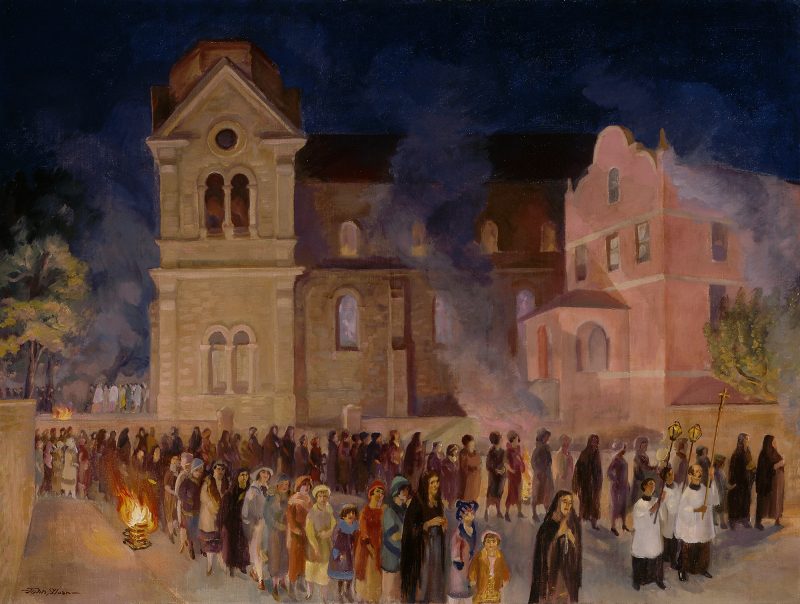
Eve of Saint Francis, Santa Fe
Sloan, John
1925
Artwork Information
-
Title:
Eve of Saint Francis, Santa Fe
-
Artist:
Sloan, John
-
Artist Bio:
American, 1871–1951
-
Date:
1925
-
Medium:
Oil on canvas
-
Dimensions:
30 1/8 x 40 1/8 in.
-
Credit Line:
Wichita Art Museum, Roland P. Murdock Collection
-
Object Number:
M83.50
-
Display:
Not Currently on Display
About the Artwork
In 1919 John Sloan, at the urging of his close friend Robert Henri, made his first trip to Santa Fe, New Mexico. Upon his arrival he was enthralled by the Pueblo Indian, Hispanic, and Anglo populations and by the beauty of the Southwestern landscape. The following year Sloan established a home and studio in Santa Fe where he resided most summers until his death in 1951.
Like many other Anglo-European artists associated with the Santa Fe and Taos art colonies, Sloan found a compelling subject in the unique religious customs of the local people. He depicted Roman Catholic ceremonies and holy-day processions. Commenting upon Eve of St. Francis, Santa Fe, Sloan noted that the “eve of the patron saint’s day is marked by a beautiful night procession leaving the cathedral in the background.”1 The occasion to which Sloan refers is not the official Feast day of St. Francis of Assisi on 4 October, but rather, a less common celebration honoring St. Francis on the eve of 2 August. Early Spanish settlers brought the tradition to New Mexico, while the Penitentes or flagellant brotherhood—an outgrowth of the Third Order of St. Francis—oversaw its continuation in the area.2
The principal ceremony that Sloan depicts in Eve of St. Francis, Santa Fe consists of an outdoor procession that starts from the church’s main entrance and winds around the grounds. Groups of female worshipers move along in two single files while reciting prayers and singing hymns. The crucifix heads the procession, whose course is high-lighted at intervals with bonfires. The bonfires eerily animate the architecture against the dark blue-black sky. Shades of blues and pinks reflect off the windows and highlight the textures of the Romanesque-Byzantine style Cathedral of St. Francis and the adobe walls of the adjacent rectory.
Although spatially the buildings occupy a greater portion of the canvas, the participants; activity remains the focal point of the scene. Sloan’s selective use of bright and pure color individualizes the women and children in the foreground, underscoring their variety in age, dress, and degrees of piety. The conservative older women wear black-fringed shawls while the younger majority sport stylish coats and hats. A young girl dressed in orange looks directly out and engages the viewer, as if acknowledging the sense of spectacle that permeates the scene. Due to her youth, she, like the uninitiated spectator, does not fully participate in the religious rite. The space that separates this child from the devout woman who bows her head and grasps her rosary beads at the head of the procession might symbolize the possibility that traditional beliefs and practices could wane with the passing of the older generations.
Although Sloan’s picture should not be viewed as an explicit social commentary, the painter did have a genuine concern for the perpetuation of local customs in the Santa Fe area, who’s ethnic and cultural richness Sloan championed in his life as well as in his art.
1. John Sloan, Gist of Art (New York: American Artists Group, Inc., 1939), 279.
2. Henning Cohen and Tristram Potter Coffin, eds., The Folklore of American Holidays (Detroit: Gale Research Company, 1988), 255-56.